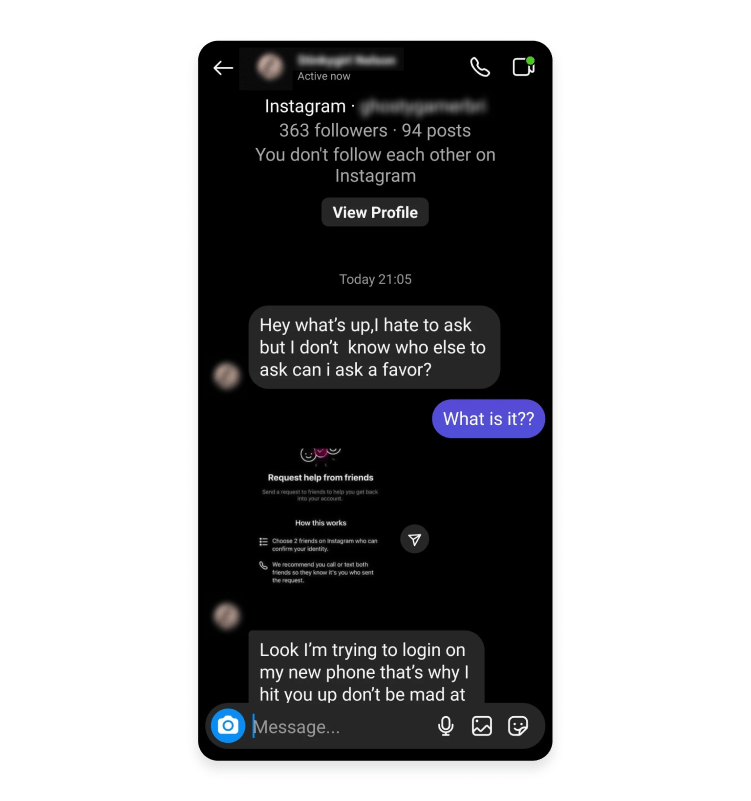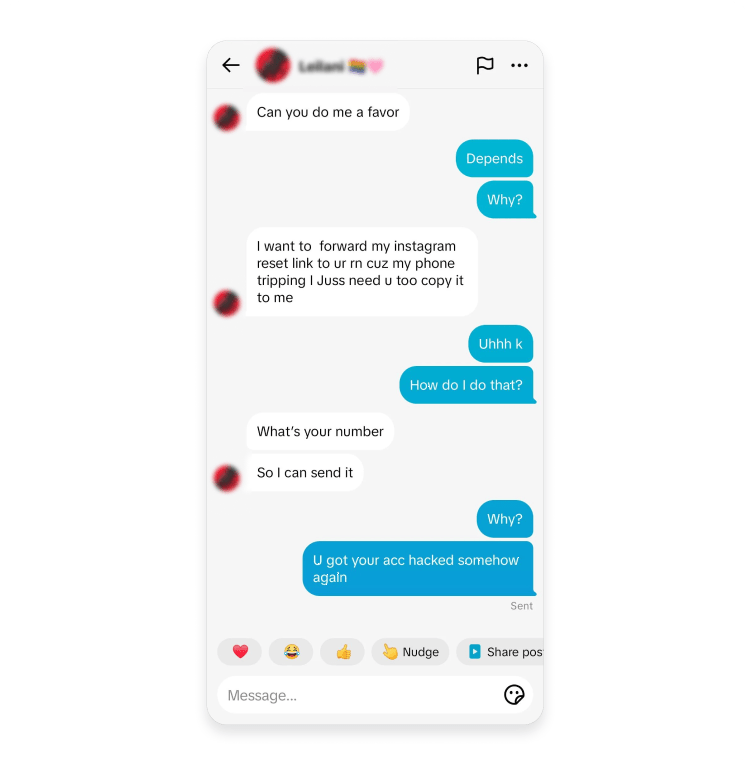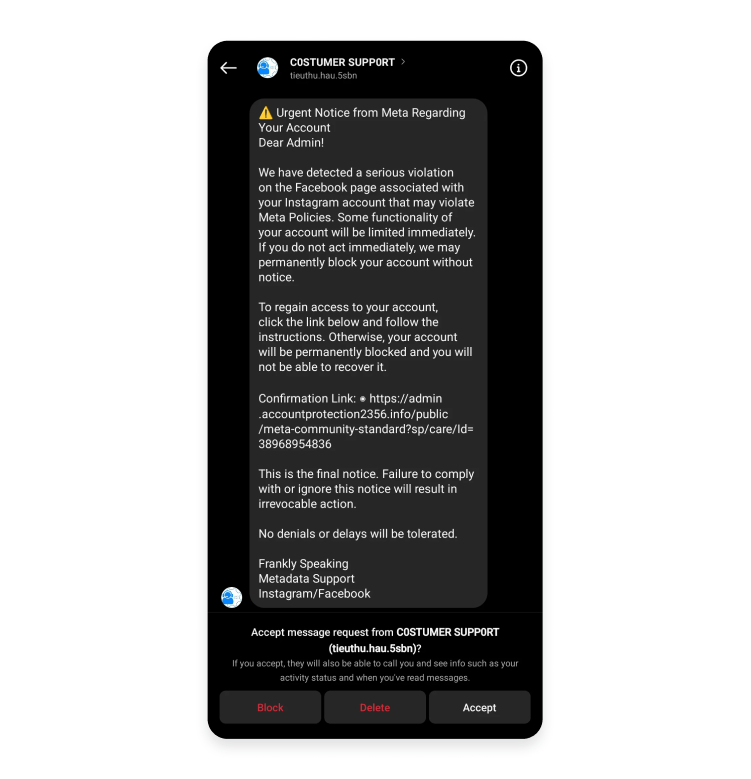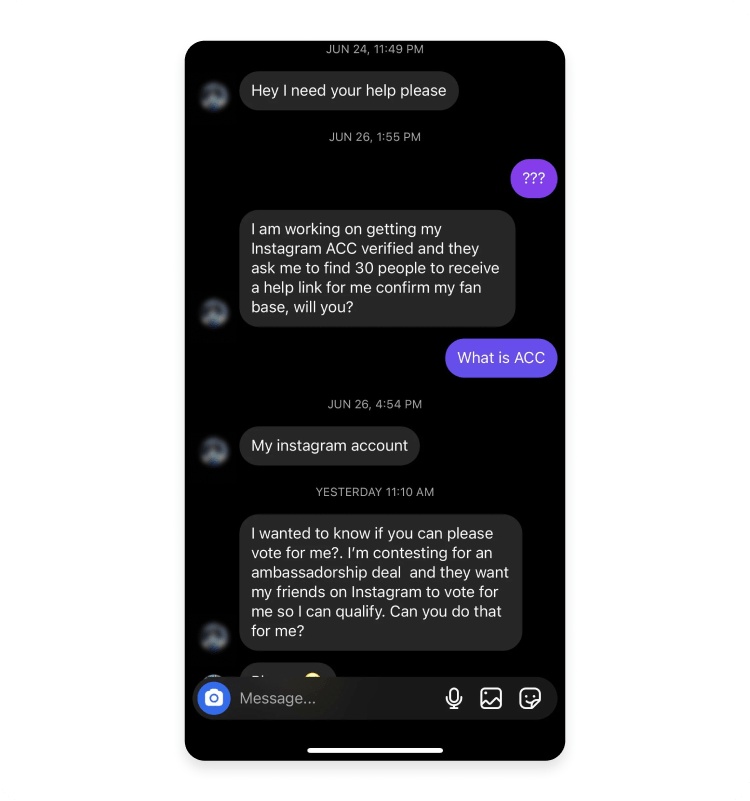Sisällysluettelo
What is Instagram phishing?
Instagram phishing (or phishing on Instagram) is one of the most common Instagram scams. It usually starts with a direct message (DM) or an email from someone pretending to be a friend, a brand you trust, or even Instagram itself. The scammer will send you a phishing URL and try to trick you into clicking it. That link might lead to a fake Instagram login page or a site that installs malware on your phone.
Scammers carry out Instagram phishing attacks to steal your personal information and make money from it. Sometimes they want your bank details to steal your money. Other times, they might be after your login details — especially if you have a lot of followers — so they can use your social media account to run scams or flood other Instagram users with spam.
Instagram phishing message examples
Not every Instagram phishing message or email is easy to recognize as a scam. Some may seem like they’re from Instagram or someone you know. Scammers know how to grab your attention — they’ll warn you about fake problems, promise rewards, or ask for help. No matter the approach, their goal is the same — to get you to click a malicious link and give up your information.
Below are six common Instagram phishing messages you should watch out for.




How to recognize Instagram phishing scams
The first step to protecting your data and social media account is learning how to spot a phishing scam on Instagram. Phishing attacks rely on human mistakes, so the more you know, the less likely you are to fall for one. Below are some common signs of a phishing attack that can help you recognize Instagram phishing before it’s too late.
Bad grammar
Bad grammar is one of the easiest ways to spot a phishing attack. Most scammers don’t pay much attention to spelling or sentence structure, and it shows. You might notice missing words, awkward phrasing, or random capital letters in some phishing emails.
Real communications from Instagram are usually clear and professional, so if something feels off or hard to read, trust your instincts — it’s probably a scam.
Shortened URLs
Scammers often hide malicious links behind URL shorteners like Bitly or TinyURL. These tools make a long Instagram phishing link look harmless, but you have no idea where that link actually leads.
Some scammers also use URL spoofing, where they create fake links that look almost identical to real ones — like “insta-help.com” instead of “instagram.com.” Unless someone you trust explains exactly why they’re sending you a shortened or unusual link, avoid clicking it.
Personal requests
Personal requests are another red flag to watch for. Instagram scammers often pretend to be someone you know — a friend, a brand, or Instagram support. They might ask for your phone number, email address, or even a screenshot of your banking account.
Real companies will never request that kind of information through a DM. If someone suddenly asks for your login details or other personal information, be careful — it’s likely an Instagram phishing attack. And if they pretend to be someone you know, give that person a call to confirm.
Sense of urgency
Scammers want you to panic, so they create a false sense of urgency. That’s why many phishing emails and messages say things like “Act now” or “Your account will be deleted in 24 hours.” They hope you’ll click a link that will lead you to a fake Instagram login page without thinking.
Banking information inquiries
It’s rare, but some scammers on Instagram go as far as asking for your bank account or payment app information. They may promise to send you money or claim you’ve won a prize — but that’s just bait.
In some cases, they’ll ask you to enter your login details into a phishing page that captures your data. No one needs your banking details to send you a giveaway or confirm your social media account. Never share that kind of information online, no matter how convincing the message might be.
Suspicious links or attachments
A message with a strange link or unexpected attachment is a big red flag. Some scammers may try to get you to click a link that looks legitimate but takes you to a phishing page designed to steal your login details.
Others might attach files that install malware on your device. Legitimate messages and emails from Instagram won’t include random links or downloads — if the message looks sketchy, delete it.
Inconsistencies in the email address
Always check who the message is really from. Scammers often use email addresses that look official at first glance but contain slight errors or strange domains. Instagram only contacts users through verified addresses like notification@facebookmail.com and noreply@facebookmail.com. If the email comes from a different email address, it’s likely fake.
Other confirmed official email addresses include:
- @business.fb.com
- @support.facebook.com
- @fb.com
- @meta.com
- @account.meta.com
- @internal.metamail.com
- @go.metamail.com
- advertise-noreply@facebookmail.com
- update@em.facebookmail.com
- @mediapartnerships.fb.com
- @global.metamail.com
Mismatched “mailed by” and “signed-by” points
When you open the drop-down details of an email (usually found near the sender’s name), you’ll see “mailed by” and “signed by” lines. In real messages from Instagram, both of these will match and show an official domain, like instagram.com or facebook.com. If the two don’t match, it’s probably a phishing attempt.
What should you do if you’ve fallen for an Instagram phishing scam?
If you think you’ve been targeted by a phishing scam on Instagram, don’t wait — take action right away. The faster you respond, the better your chances of keeping your account safe.
- If you can still log in, change your password immediately. Use a strong, unique password that you haven’t used on any other platform. Then, log out of any devices you don’t recognize. Once you have done the above, check your account settings to make sure no one changed your email or phone number. Then, go to the “Accounts center” to see if any unfamiliar profiles are linked to your account — if they are, remove them.
- If you can’t log in, follow Instagram’s account recovery steps to reset your password and regain access to your account. Your Instagram account may have been hacked.
Even if you didn’t click anything, report phishing emails by forwarding them to phish@instagram.com. Reporting phishing emails helps Instagram stop similar scams.
How can you protect yourself from Instagram phishing scams?
Phishing scams are everywhere on social media — but with the right habits, you can avoid falling for them. Below are a few simple but effective tips on how to stay safe on social media, including how to make sure your Instagram account stays in safe hands (yours!)
- Enable two-factor authentication (2FA). If you haven’t already, enable 2FA and use a trusted app like Google Authenticator. This extra layer of security will protect your account even if someone gets your password.
- Use strong and unique passwords. Don’t rely on easy-to-guess passwords like your name, birthday, or “123456.” A strong password should be long, include a mix of letters, numbers, and symbols, and be different from the ones you use on other accounts.
- Avoid clicking suspicious links. Most phishing scams start with a link that looks harmless but leads to a fake login page or a phishing website that installs malware. Scammers might send these links through DMs, emails, or even comments. If the message feels strange, the link looks odd, or you weren’t expecting it — don’t click.
- Double-check URLs before logging in. Always look closely at links. On a computer, hover over them. On a phone, long-press to preview the address. If you’re about to log in, make sure the link starts with “instagram.com.” If it’s a shortened URL, avoid clicking it unless you’re absolutely sure it’s safe. When in doubt, you can also use a link checker tool to see if the URL has been flagged as dangerous.
- Check the sender’s email address. If you get an email from Instagram, it should come from @mail.instagram.com, @support.instagram.com, or another official domain. If it’s not, it’s almost certainly a phishing attack.
- Ignore random DMs claiming to be from Instagram. Neither Instagram nor other businesses send messages about account issues through DMs. Unless you contacted them first, it’s probably a scam.
- Report phishing emails. Forward suspicious emails to phish@instagram.com — even if you didn’t click anything.
- Use a trusted VPN with phishing protection. Any NordVPN plan that includes the Threat Protection Pro™ feature will save you from visiting phishing websites. You will also be notified if you enter a page known for fraud or scamming people.
- Secure your email account. Your email is the key to your Instagram. Use a strong password and enable 2FA on your email as well. If someone gains access to your inbox, they may be able to take over your Instagram account.
- Don’t use bots and auto-follow tools. If you’re interested in using auto-follow services or bots, don’t. These services often ask for access to your sensitive data. Some are built by scammers looking to steal accounts. It’s not worth the risk.
Verkkoturvallisuus käynnistyy napsautuksella.
Pysy suojattuna maailman johtavan VPN:n avulla
